(This Retrospective article was published in the June 2008 issue of Rider.)
STORY AND PHOTOS BY CLEMENT SALVADORI
It was the early 1980s when the Japanese really got their sporting act together with liquid-cooled engines, single-shock suspensions, and frames that could handle the power in the corners.
Yamaha was third in line, after Honda’s Interceptor 750 and Kawasaki’s Ninja 900, as the company put the FZ750 on the market in the spring of 1985. The 750 production class was hot back then, and Yamaha hit it right on target.
The motorcycle market and the world’s economy in general were imploding in the mid-1980s, but these designs had been in the pipeline and would not be denied. There was not much profit to be made from super-sporty models, but they were the flagships, got the attention, needed to be built…and the technology that was so expensive to come by would dribble down to more mundane bikes in future years. Every OEM was racing for the racer’s edge.
Of course the marketing folk in Hamamatsu wanted something to boast about, other than having a typical UJM in-line four with two overhead camshafts, and the engineers had provided this by adding a third intake valve to the heads. So instead of 16 valves to adjust there were now 20, but the theory was that with three valves more fuel could be sucked into the combustion chamber, and more fuel equals bigger explosion, and bigger explosion equals more power. And they stuck to that story for 20 years. Yamaha liked to call this the Genesis engine.
Nobody could deny that it was a pretty good machine, and the advertising boasted that the ’85 model had 102 horsepower at the crankshaft, and could do the quarter-mile in under 11 seconds. Slightly more real-world testing done by magazines showed 85 rear-wheel horses, and a quarter-mile in a little over 11 seconds. The public always allowed the ad guys a bit of slack, and a 15 percent reduction between crank and road-surface is acceptable.
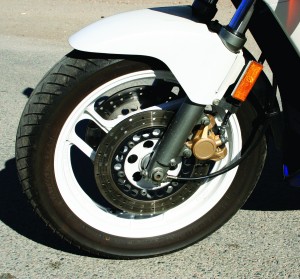
This FZ750 really was a superb show of astute engineering, and the predecessor XJ750 was an instant dinosaur. First thing to be admired on the FZ was the narrowness of the grossly oversquare engine, with 68mm bores, 51.mm strokes, hard to achieve when the cylinder liners needed coolant. The easy part was tucking the alternator and starter behind the cylinders, the innovative bit was using wet-liners only at the hottest part of the cylinders, the middle. The skinny engine was only a shade over 16 inches wide, with a narrow crank, the whole thing sitting lower in the frame and keeping the weight down where it belonged. And it was a short engine/ tranny package as well, just 6 inches from crankshaft to output shaft.
The five-valve theory was valid, considering the fact that more valves meant smaller, lighter valves, and smaller valves could be moved up and down faster and did not have to move as far to allow the mixture in. The black box cut into the fun at 11,800 rpm. For the record, Yamaha had also contemplated a seven-valve head as well, but obvious complications put that one on the shelf.
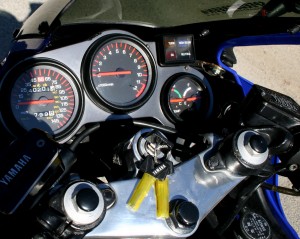
The combustion chambers were shallow in the dome, matched with a shallow dip in the pistons, and reliefs for the valves—a long time ago engine designers figured that having a valve touch a piston was not a good idea. Yamaha understood that this new-fangled unleaded gasoline could create problems, especially when running a compression ratio of over 11 to 1. What the matching concavities did was to focus the intake of fuel from the 34mm carbs into the center, where the single spark plug was—Bang! A clean explosion was the result, with none of that dreary knocking. The carbon residues all went out a four-into-two exhaust…the astute reader will note that the original item has been changed to a four-into-one Yoshimura pipe on this 20-year-old.
The frame this sat in was a singularly unattractive but effective cradle made of box steel, with wide upper arms creating a perimeter around the top of the engine; there was not going to be any unnecessary flex in this chassis. The factory was kind enough to include several bolt-on sections in order to get the engine out. Overall wheelbase was 58.5 inches, and the steering head was angled at a steepish 25.5 degrees, both to ensure quick steering…and to concentrate engine weight onto the front wheel. To this end the cylinders of the engine were canted forward at 45 degrees, an unusually severe angle. The engine—which had no counterbalancers—was solidly bolted in, so there was the inevitable buzz at middling rpm, but since the bike was to be ridden at high rpm who should care?
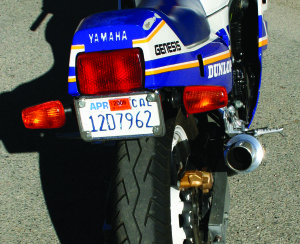
A 39mm fork had a built-in brace, simple and functional air-assisted valving, and connected with the axle of a 16-inch front wheel carrying a 120/80 tire. And it was obvious that a slightly larger 140 tire could be fitted with no problem, the size that race-conscious riders preferred. This gave a rather short trail of 3.7 inches.
At the back was an aluminum swingarm with a single rising-rate shock that had adjustable spring preload and rebound damping, and an 18-inch wheel with a 130/80 tire—and a 160 size would easily go in there.
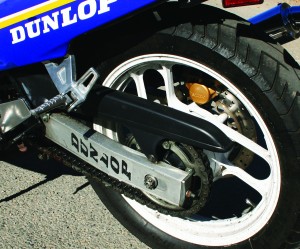
With a top speed approaching 150 mph (on a stock 750!?) good brakes were essential, so the front wheel had
a pair of ventilated discs with opposed-piston calipers and the latest in semi-metallic pads. The rear disc had a single piston pushing against the disc.
The original FZ750 had a half fairing with decals denoting its five valves. Which became a full fairing on the aberrant FZ700 of 1987, destroked to 697cc, with a GENESIS decal on the tailpiece. The owner of this model has replaced several body pieces for mysterious
reasons, and is lacking a couple of decals.
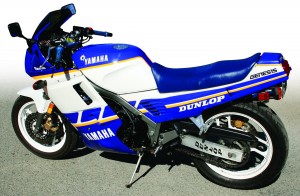
Time and development wait for no rider, and while the FZ700 was intended for the cost-conscious purchaser, the new ’87 FZR750R with the Deltabox frame and the way higher price was for the racer who wanted to win races. The FZ reappeared as a 750 in 1988, and then went the way of all out-moded motorcycles.








Ive just read this report on the early FZ 750 Genesis, and find it totaly inaccurate. This bike was “confirmed ” as the first 150 mph 750 cc bike in the world, and even the one i bought for spares , with 66 k and 4 in 1 pattern exhaust, was still going at 140 !, if this report were accurate, then he would comment on the brakes ! . Truley awfull ! 16″ front wheel, means that you steer in very quickley, so your braking has to be done when you take the corner as a 16″ rotates much faster than the 17 or 18″ used today.The front brakes were totaly inadiquate,and caused no end of corner entry problems. The easy solution, is to change rear wheel to exup , and trust me, you can get a 180″ inside the swing arm, and forget the front brakes,as you can use your corner speed to put the power down, harder and earlier because of the extra grip you will have at the rear end. Trust me. Enter a corner fast as you like, The exit matters more.
I need Genesis 750 wiring harness and relays and complete fairing and fenders and exhaust and fuel tank for my Yamaha Genesis 750
Buenos Dias Amigos Moteros. Tengo una Yamaha FZR 750 R de 1987 OW01 Numero 281. No encuentro este Modelo ni en Wikipedia. Podria alguien AYUDAR a encontrar este modelo no se si solo se vendio en U.S.A. Muchas Gracias Saludos a todos Jose
I have had and 86 fz 750 setting around sense 91 it only has 9800 miles on it I got it from the brother of the original owner that tragically passed away . I could never find parts for it so over the years I have gotten a pet from here and a part from there it has been upgraded to a 88 fj 750 front end with its large fronting disks and 4 piston calipers it now has after market rims 17 s from the and rear what I am looking for are the front full fairing and a 4 into1 exhaust and im also looking for a 88 fj head light it twin round head lights dose anyone know where I can Find them